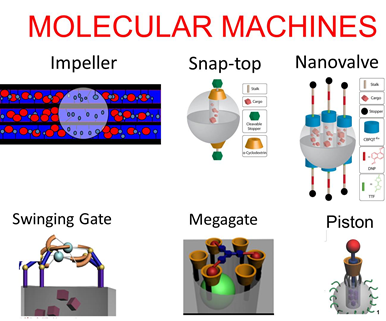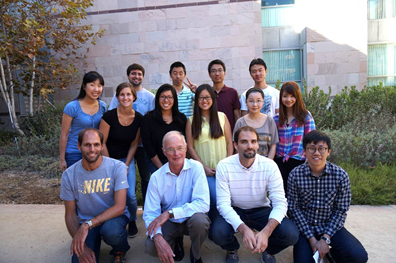02/04/2015
A pequena grande revoluûÏûÈo de Zink na 38ôˆ. RASBQ
Pioneiro em nanopartûÙculas mecanizadas cobre novas perspectivas para o tratamento contra o cûÂncer e
outras doenûÏas intracelulares

|
|
Propulsores, tampas que abrem e fecham por comando, vûÀlvulas e dispositivos para levar fûÀrmacos diretamente a cûˋlulas doentes. Tudo isso em tamanhos aproximados de um milhûÈo de vezes menor que 1mm.
|
|
|
|
|

|
|
As conquistas de Jeffrey Zink e seu grupo deram origem û 'nanoterapia'.
|
Diz o velho ditado, com alguma simplicidade, que "tamanho nûÈo ûˋ documento". Mas o quûÙmico Jeffrey Zink deu um novo e promissor significado û s sûÀbias palavras conhecidas em muitas lûÙnguas. Ele mergulhou no "nanomundo", aquele em que as coisas sûÈo um milhûÈo de vezes menores que um milûÙmetro, e revolucionou a medicina. Sim, a nanoterapia apresenta possibilidades gigantescas no tratamento do cûÂncer e de outras doenûÏas infecciosas intracelulares, como a tuberculose.
û sobre esta pequena grande revoluûÏûÈo que Jeffrey Zink falarûÀ na 38ôˆ. ReuniûÈo Anual da SBQ, a ser realizada em maio, em ûguas de Lindû°ia (SP).
Em seu laboratû°rio na Universidade UCLA (EUA), Zink e o grupo de pesquisadores que coordena, criaram nanovûÀlvulas, nanopropulsores e nanopistûçes, capazes de transportar fûÀrmacos atûˋ cûˋlulas cancerosas em ratos, eliminûÀ-las e curar os animais. O mesmo feito foi obtido no tratamento da tuberculose. "Em breve serûÀ possûÙvel realizar testes clûÙnicos com humanos", celebra o quûÙmico.
Uma plataforma nanoterapûˆutica ideal, explica Zink, deve ter a capacidade de transportar diferentes cargas moleculares (como fûÀrmacos com diferentes propriedades fûÙsico-quûÙmicas), ser programûÀvel, controlûÀvel para liberar o fûÀrmaco apenas nas cûˋlulas cancerûÙgenas ou infeccionadas (poupando cûˋlulas sadias), com toxicidade mûÙnima.
Seu grupo de pesquisadores foi pioneiro no uso de nanopartûÙculas de sûÙlica mesoporosas (MSNs), como veûÙculos eficientes para carregar fûÀrmacos com atividade anticûÂncer. Estas partûÙculas contûˆm milhares de poros com grande ûÀrea superficial, com capacidade para armazenar os fûÀrmacos. "Mais do que isso, as nanopartûÙculas que projetamos tûˆm vûÀlvulas que abrem e fecham seguindo comandos, de modo que o terapeuta tem controle temporal e espacial sobre a descarga dos fûÀrmacos nas cûˋlulas almejadas", observa Zink.
Jeffrey Zink formou-se em QuûÙmica da Universidade de Winsconsin e obteve o tûÙtulo de Doutor na Universidade de Illinois, de onde se mudou para a Califû°rnia para trabalhar na UCLA, onde leciona e coordena um grupo de pesquisadores. û um membro do California NanoSystems Institute e professor convidado nas universidades de Paris e Amsterdam. Tem cerca de 400 artigos publicados.
O professor Zink conversou com o Boletim da SBQ
What kind of nanomachines and "nanosolutions" has your research group developed and how do they change the perspective of medical treatments?
An ideal 'adaptable' nanotherapeutic platform should have: 1) the capacity for carrying high levels of multiple diverse molecular cargos (small molecules, drugs with varying physiochemical properties, siRNAs, peptides, imaging agents); 2) programmable specificity for binding, delivery and targeting cancer or infected cells, while avoiding healthy cells; 3) controlled and triggered release capability; and 4) minimal immunogenicity and toxicity. The mechanized mesoporous silica nanoparticles with internal pores and nanovalves enabling stimulus-responsive drug release, and surface modifications for organ, cancer cell, and cytoplasm targeting possess these desirable characteristics. In our research program we are designing a new generation of nanotherapeutic platforms with sequence, specificity, and function that can be programmed to cure cancer and infectious diseases.
We pioneered mesoporous silica nanoparticles (MSNs) as an efficient vehicle for the delivery of anticancer drugs; MSNs contain thousands of pores with a large surface area that allows the particles to be filled with a drug, (and MSNs can also be coated with a polymer layer that can carry siRNA). Furthermore, our uniquely designed MSNs contain nanovalves that can open and close on command, giving us precise spatial and temporal control over cancer treatment.
A sketch of the operation of mechanized mesoporous silica nanoparticles that are capped by nanovalves is shown in the attached figure. The moving parts are molecular machines that contain bulky moving parts that act as gatekeepers of the pores' openings. We have successfully demonstrated that the motion can be triggered by recognition events (pH, redox, charge, metal ions and biomolecules such as enzymes) and also by external stimuli (light, magnetic fields). When the bulky group moves away from the pore orifice the therapeutic drugs in the pore will escape. Nanomachines that respond to intracellular and/or external stimuli will deliver large concentrations of drugs only to diseased locations.
We have developed a wide variety of types of nanomachines. They include nanovalves (described above), nano impellers (that push drug molecules out of the pores in the nanoparticles), snap-top gatekeepers that hold drugs in pores until snapped open like the cap on an aluminum can, nanogates and megagates, etc. In all cases the moving parts undergo large amplitude motions in response to stimuli.
What are the keys to efficiency and success in chemical research?
The key ingredients for success are intelligence, creativity and imagination, and hard work. Luck is also helpful, but as Pasteur said, "chance favors the prepared mind".
How far or close are your findings from the daily usage in medical centers throughout the world?
Our nanomachines are able to carry anticancer drugs to tumors in mice, shrink the tumors and cure the animals. They also carry antibiotics to macrophages carrying infectious bacteria that cause tuberculosis, and we can cure mice of TB. Clinical trials involving humans are possible in the near future.
On a typical day, how do divide your hours between laboratory, classes and non-working hours? What are your hobbies?
Among the joys of academia is that each day can present new scientific results, new challenges to understand the results, new opportunities to learn from seminars and the literature, and continuous opportunities to create. Each week has regularly scheduled events such as teaching courses, holding group meetings, departmental service, and seminars by invited scientists. In my formal classroom teaching I get to know and to help young scientists learn, and in my informal interactions with my research group I teach (and learn) from results of our experiments.
My hobbies include hiking in the mountains of California and forests in Wisconsin, natural history, bird watching and music. In addition to hiking, my favorite form of exercise is swimming. I also enjoy classical music, opera and reading.
Why should youth study sciences and specifically Chemistry?
Young people should follow their interests and never stop learning. If they like to understand how things work (especially at the molecular or the nano level) they should study chemistry. The field provides infinite opportunities to creatively make new things, to constantly expand knowledge, and also to provide the opportunity to do things that will help humanity. In our own work we use physical principles involving light and magnetism, and chemical principles and synthesis to create never-before imagined nanomachines. We learn how to design them to do what we want them to do, and then apply them to solve biomedical problems.
A message to the Chemical community in Brazil?
I am honored to have to opportunity to tell the Brazilian chemical community about my own research and I hope that the subjects that I talk about will inspire young chemists to explore and develop their own ideas and further advance the field.
Artigos sugeridos
“Mechanized Silica Nanoparticles: A New Frontier in Theranostic Nanomedicine”, M. W. Ambrogio, C. R. Thomas, Y. Zhao, J. I. Zink, J. F. Stoddart,ô Acc. Chem. Res. 2011, 44, 903ã913.
“Mesoporous silica nanoparticles in biomedical applications”, Z. Li, J. C. Barnes, A. Bosoy, J. F. Stoddart, J. I. Zink,ô Chem. Soc. Rev. 2012, 41, 2590-2605.
“Mesoporous Silica Nanoparticle Nanocarriers: Biofunctionality and Biocompatibility”, D. Tarn, C. E. Ashley, M. Xue, E. C. Carnes, J. I. Zink, C. J. Brinker, Acc. Chem. Res. 2013, 46, 792.
“A reversible light-operated nanovalve on mesoporous silica nanoparticles”, D. Tarn, D. P. Ferris, J. C. Barnes, M. W. Ambrogio, J. F. Stoddart, J. I. Zink, Nanoscale 2014, 6, 3335.
“Functional Nanovalves on Protein-Coated Nanoparticles for In vitro and In vivo Controlled Drug Delivery”, A. A. Hwang, J. Lu, F. Tamanoi, J. I. Zink, Small 2015, 11, 319-328.
A 38ôˆ ReuniûÈo Anual da SBQ serûÀ no Hotel Monte Real, ûguas de Lindû°ia, SP de segunda, 25/maio/2015 a quinta, 28/maio/2015. Para detalhes do evento, visite: http://www.sbq.org.br/38ra/
Curta a pûÀgina da 38ôˆ RA e acompanhe as novidades do evento! Convide tambûˋm seus amigos. Juntos, faremos uma grande reuniûÈo anual!
Texto: Mario Henrique Viana (Assessoria de Imprensa da SBQ)
|